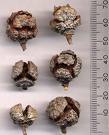Baker Cypress Tree Information
Images of Baker Cypress:






Baker Cypress grows in the following 2 states and provinces:
California, OregonInformation about Baker Cypress:
The Cupressus Bakeri is commonly known as the Baker Cypress, Modoc Cypress as well as Siskiyou Cypress.
The currently accepted scientific name of Baker cypress is Cupressus bakeri Jeps. . There are no recognized hybrids, varieties, or forms. Two subspecies are recognized by some authors : Cupressus bakeri ssp. bakeri Jeps. Baker or Modoc cypress Cupressus bakeri ssp. matthewsii Wolf Siskiyou cypress Dodd and Rafii assert that population studies of morphological and chemical diversity in Baker cypress do not support subspecies status and believe that it should be discontinued. Hickman's taxonomic classification shall be used for this paper. Baker cypress is restricted to northern California and southern Oregon. Baker cypress (C. b. ssp. bakeri) occurs in Modoc, Plumas, Shasta, and Siskiyou counties in California . Siskiyou cypress (C. b. ssp. matthewsii) has disjunct populations in the Siskiyou Mountains of Josephine County, Oregon, and on Goosenest Mountain in Siskiyou County, California . The Bureau of Land Management administers the Baker Cypress Natural Area and Timbered Crater Baker Cypress Natural Area, both in Siskiyou and Modoc counties, California .Baker cypress is a component of the northern interior cypress forest. This habitat type is an open, fire-maintained, scrubby forest similar to the knobcone pine (Pinus attenuata) forest. It is associated with serpentine chaparral, and intergrades on less severe sites with upper Sonoran mixed chaparral, montane chaparral, or knobcone pine forest community types. On more mesic sites, the northern interior cypress forest intergrades with mixed evergreen forest or montane coniferous forest . Baker cypress rarely forms pure stands . The Timbered Crater grove is associated with yellow pine (Pinus ponderosa and P. jeffreyi) forest and suggests a transition zone between several plant communities, including northern juniper woodland, yellow pine forest, and sagebrush scrub. High elevation groves of Baker cypress in Plumas County, California, are associated with red fir (Abies magnifica) forest . Species not already mentioned that are commonly associated with Baker cypress include sugar pine (Pinus lambertiana), Brewer oak (Q. garryana ssp. breweri), Sadler oak (Q. sadleriana), incense-cedar (Calocedrus decurrens), Brewer spruce (Picea breweriana), Pacific yew (Taxus brevifolia), juneberry (Amelanchier pallida), greenleaf manzanita (Arctostaphylos patula), big sagebrush (Artemisia tridentata), whitethorn ceanothus (Ceanothus cordulatus), wedgeleaf ceanothus (C. cuneatus), deerbrush (C. integerrimus), Lemmon ceanothus (C. lemmonii), squawcarpet (C. prostratus), snowbrush ceanothus (C. velutinus), California redbud (Cercis occidentalis), birchleaf mountain-mahogany (Cercocarpus betuloides), desertsweet (Chamaebatiaria millefolium), bush chinquapin (Chrysolepsis sempervirens), low rabbitbrush (Chrysothamnus viscidiflorus), Fremont silktassel (Garrya fremontii), western juniper (Juniperus occidentalis), bitter cherry (Prunus emarginata), Klamath plum (P. subcordata), western chokecherry (P. virginiana var. demissa), skunkbush sumac (Rhus trilobata), baldhip rose (Rosa gymnocarpa) creeping sage (Salvia sonomensis), antelope bitterbrush (Purshia tridentata), gooseberry (Ribes spp.), buckwheat (Eriogonum spp.), honeysuckle (Lonicera spp.), pussy paws (Calyptridium umbellatum), larkspur (Delphinium spp.), bedstraw (Galium spp.), and goosefoot violet (Viola purpurea) . Some of the information provided here is attributed to:Esser, Lora. 1994. Cupressus bakeri. In: Fire Effects Information System, [Online]. U.S. Department of Agriculture, Forest Service, Rocky Mountain Research Station, Fire Sciences Laboratory (Producer). , available at the USDA Fire Effects Information System (FEIS) website